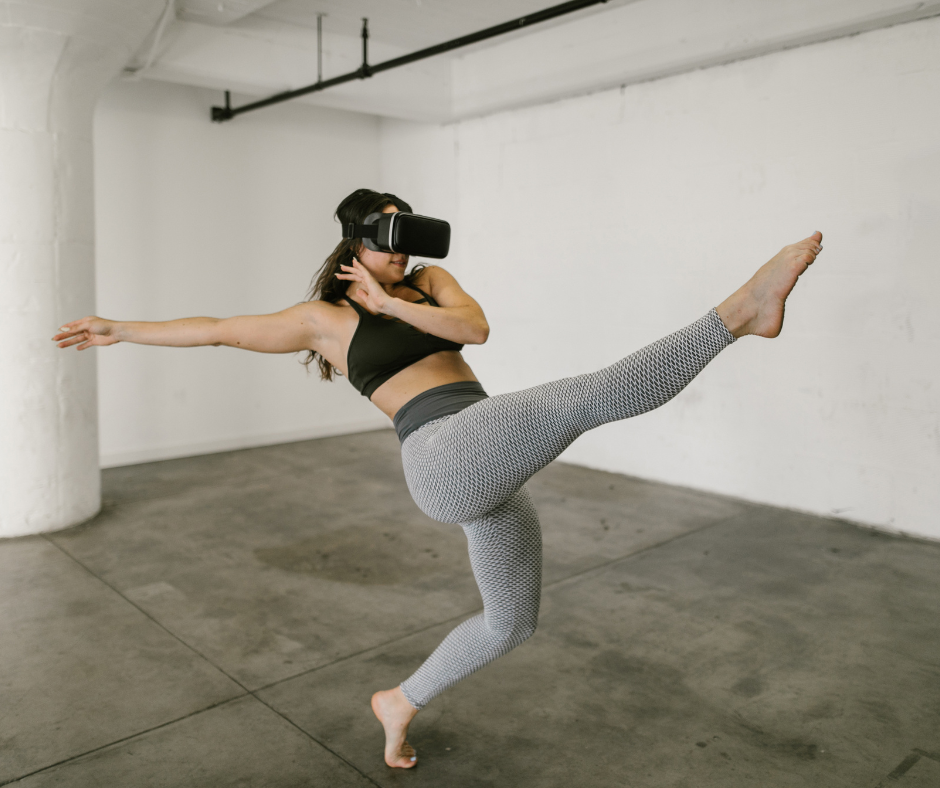

From Massage to Wearables: Haptic Technology for Stress Relief
Summary
Reflection Questions
Journal Prompt
Stress affects the mental health and well-being of millions globally. Amidst this backdrop, the quest for innovative and effective stress relief methods has led to the exploration of haptic technology—a sophisticated realm of tactile feedback that simulates the sense of touch through vibrations, forces, and motions. Haptic technology, once primarily associated with enhancing user experiences in gaming and virtual reality, is now stepping into the wellness spotlight. By creating immersive and soothing tactile sensations, it offers a unique avenue for alleviating stress and enhancing relaxation. As women grapple with ever-increasing stress levels, the emergence of haptic technology as a tool for stress relief represents a promising frontier. It not only underscores the importance of touch in human interaction and well-being but also highlights the potential for technology to play a crucial role in improving mental health outcomes. Read on to learn more!
Women and Stress: What Statistics Say


Research consistently indicates that stress affects a significant portion of the population, with many studies suggesting that women report higher levels of stress compared to men. According to the American Psychological Association’s (APA) stress statistics, women often report higher stress levels than men.
For instance, in their annual stress surveys, it has been noted that women are more likely to report that their stress has increased over the past year and are more likely to rate their stress levels as higher than what they believe to be healthy. According to the 2023 Stress in America survey, “Women continue to report higher stress levels than men and could have used more support.” In fact, women again reported “Higher average level of stress than men (5.3 vs. 4.8 out of 10) and were more likely to rate their stress levels between an eight and 10 than men (27% vs. 21%).”
It’s also important to consider that the sources and manifestations of stress can differ significantly between genders, influenced by factors such as work, relationships, financial pressures, health concerns, and the balancing of multiple responsibilities. Additionally, societal and cultural expectations can disproportionately affect women, potentially contributing to higher stress levels.
The Insidious Impacts of Stress on Women


Stress manifests in women through a variety of physical, mental, and behavioral effects that can significantly impact their overall health and quality of life. Let’s take a look at some of the ways stress can manifest in women.
Physical Health Implications
Biologically, women may experience hormonal imbalances due to stress, leading to irregular menstrual cycles, changes in menstrual flow, and intensified premenstrual symptoms. These hormonal disruptions can extend to fertility issues, making it more difficult for stressed women to conceive. Additionally, stress is often linked to weight gain, particularly because it can alter eating behaviors and increase cortisol production.
Another significant physical impact is on heart health; women, especially post-menopausal ones, face a higher risk of heart disease exacerbated by stress-related high blood pressure and cholesterol levels. Stress also weakens the immune system, rendering women more susceptible to infections and illnesses.
Cognitive Implications
Mentally, the toll of stress is evident in the heightened risks of anxiety and depression among women, conditions that are more commonly reported by females facing stress. Sleep disturbances are another consequence, with stress leading to trouble falling asleep, staying asleep, or enjoying restful sleep. Over time, these patterns can severely affect cognitive functions, including memory, focus, and decision-making capabilities.
Behavioral Implications
Behaviorally, stress might push women towards increased substance use as a coping mechanism, potentially leading to abuse and dependency. It can also trigger or exacerbate eating disorders, driven by stress-induced changes in eating habits.
The repercussions of stress extend into social and relational aspects of life, straining relationships with partners, family, and friends due to increased irritability, mood swings, and a tendency to withdraw from social interactions. Women juggling the demands of work and personal life may find stress exacerbates challenges in maintaining a healthy work-life balance, leading to burnout and dissatisfaction.
Mental Health Implications
The mental health implications of stress in women are both significant and multifaceted, reflecting a complex interplay between psychological, biological, and socio-cultural factors. Stress can lead to a range of mental health conditions, with anxiety and depression being among the most common. Women, in particular, report higher levels of stress compared to men and are more susceptible to these stress-induced mental health issues.
Anxiety disorders can manifest as generalized anxiety, panic attacks, or specific phobias, all of which may be exacerbated by or directly result from chronic stress. The constant state of worry and tension not only impairs daily functioning but also contributes to a vicious cycle where stress feeds into anxiety, further elevating stress levels.
Depression in women under stress can range from mild to severe episodes, affecting their ability to work, interact socially, and manage daily tasks. The relationship between stress and depression is bidirectional; stress can lead to depressive episodes, while existing depression can intensify the perception of stress, creating a debilitating loop.
Reproductive and Maternal Health
Now, consider how stress can impact reproductive and maternal health. Stress during pregnancy is linked to complications such as preterm labor and developmental issues in the fetus, and it is a known risk factor for postpartum depression. This condition can hinder a mother’s ability to bond with her newborn and manage the responsibilities of motherhood effectively.
The multifaceted impacts of stress on women underscore the importance of targeted interventions and support systems to mitigate these effects, including stress management techniques, lifestyle changes, and professional help, to improve their health and well-being.
Understanding Haptic Technology as a Tool for Stress Relief


Haptic technology refers to the science and practice of applying touch (tactile) sensation and control to interaction with computer applications. By simulating the senses of touch and motion as they provide haptic feedback, these devices can replicate the experience of interacting with real-world objects.
This technology enables users to feel textures, vibrations, and other tactile sensations through devices like gloves, vests, and controllers, enhancing the user’s experience in digital and virtual environments. We now see haptic feedback incorporated in everything from virtual reality (VR) experiences to remote-controlled surgeries, offering a more immersive and intuitive way to interact with technology.
The Evolution of Haptic Technologies
The concept of haptic technology dates back to the 1950s and 1960s, with early developments focused on kinesthetic feedback in flight simulators and teleoperation systems. However, it wasn’t until the 1990s that haptic interfaces began to gain prominence, spurred by advances in computer technology and robotics. The field has since evolved rapidly, with significant milestones including the development of force feedback devices for gaming consoles and the integration of tactile feedback in smartphones.
Today, haptic technology is an integral part of many cutting-edge applications, from medical training simulators to virtual reality gaming, showcasing its evolution from a niche concept to a mainstream technological solution.
How Haptic Devices Create Touch Sensations
Haptic systems create touch sensations by applying forces, vibrations, or motions to the user. These sensations are generated through actuators or motors that can deliver a wide range of tactile stimuli, simulating everything from the smoothness of silk to the roughness of sandpaper. The basic principle involves converting electrical signals into mechanical movement, which then translates into tactile feedback experienced by the user.
This feedback can be as simple as a vibration alert on a mobile phone or as complex as the varied textures and resistances felt in a high-fidelity haptic glove. The technology relies on precise control systems to modulate the intensity, direction, and duration of these sensations, enabling a realistic and responsive interaction with digital content.
The Science of Touch and Stress Relief


The human touch response system is a complex network of nerves, sensors, and areas in the brain that process tactile stimuli, playing a crucial role in emotional regulation and stress relief. Touch, one of the first senses to develop in humans, has a profound impact on our psychological and physical well-being.
It can convey safety, love, and trust, activating the body’s relaxation responses and reducing the production of stress hormones such as cortisol. This calming effect is why physical touch is integral to human connection and why it can significantly lower stress levels, enhance mood, and even improve immune function. The importance of touch in emotional regulation underscores its potential as a therapeutic tool for stress relief and mental health support.
How Physical Touch Can Simulate the Release of Stress-Relieving Hormones
Physical touch not only plays a role in reducing stress hormones but also in stimulating the release of positive hormones such as oxytocin, often referred to as the “love hormone” or “cuddle hormone.” Oxytocin is released in response to physical touch like hugs, handholding, or even a friendly pat on the back, promoting feelings of contentment, reducing anxiety, and enhancing social bonding.
This hormone acts on the parasympathetic nervous system, which is responsible for relaxation and recovery, and helps to mitigate the effects of stress. The release of oxytocin through touch highlights the biological basis for human beings’ innate need for social interaction and physical connection as a natural, effective means of stress relief.
How Haptic Technology Mimics Human Touch to Induce Similar Stress-Relieving Effects
Haptic technology seeks to replicate the stress-relieving effects of human touch by simulating tactile sensations through electronic devices. By employing various mechanisms to deliver vibrations, pressures, and textures that mimic real-life touch experiences, haptic feedback can evoke similar physiological responses in the body, including the release of oxytocin.
This technology is particularly promising in environments where direct human contact is not possible, such as a virtual environment for stress management or remote communication. Through precise and nuanced feedback, wearable haptics and remote controlled robotic tools can induce relaxation, comfort, and emotional connection, offering a bridge between the digital and physical worlds to harness the therapeutic power of touch.
Various Applications of Haptic Technology for Stress Relief
Haptic Technology in Massage Therapy


Haptic-based massage devices, including technologically advanced chairs and portable handheld units, incorporate haptic feedback mechanisms to simulate the sensation of a massage. These devices are designed to replicate the touch, pressure, and movements typically provided by a massage therapist.
Massage chairs can offer a full-body experience, using motors, rollers, and airbags to apply pressure and movement across the body. Handheld devices, on the other hand, are more focused, allowing users to target specific areas of tension. These gadgets are equipped with varying intensity levels and modes to mimic different massage techniques such as kneading, tapping, and shiatsu, providing users with a customizable massage experience at their convenience.
Haptic-based massage devices simulate various massage techniques through the use of mechanical components and software algorithms that control movement patterns, pressure, and rhythm. These components work together to mimic the hands and techniques of a professional masseuse, providing therapeutic benefits such as muscle relaxation and stress relief.
For instance, rollers may move in patterns that emulate the kneading motion of hands on the back, while vibration features can simulate the tapping technique for stimulating circulation. Airbags inflate and deflate to replicate the pressure and release sensation of a deep tissue massage, helping to relieve muscle tension and promote relaxation.
Wearable Haptic Devices for Everyday Stress Management
Wearable haptic devices have emerged as innovative tools for stress management, designed to be worn throughout the day like traditional accessories. These devices, including wristbands and vests, incorporate haptic feedback technology to deliver tactile sensations that can help soothe and reduce stress levels in users.
They are engineered to provide comfort and relaxation by simulating gentle touches, hugs, or calming vibrations. These realistic sensations mimic the therapeutic effects of human contact or massage. The wearable nature of these devices allows for continuous support and stress relief, integrating seamlessly into the user’s daily life without disrupting their routine.
How These Devices Work
Wearable haptic devices for stress relief work by employing various features like customizable vibration patterns, temperature control, and even biofeedback mechanisms that respond to the user’s physiological state. For instance, a haptic wristband might use a series of gentle vibrations to mimic the rhythmic tapping that is known to induce relaxation.
Some devices can be programmed with different modes to either energize or calm the human body, depending on their needs at the moment. Advanced models may also include sensors that detect increases in heart rate or skin conductance (a measure of stress), triggering calming vibrations automatically to help the user manage stress responses in real-time.
Immersive Stress Relief through VR and Haptic Feedback


Virtual Reality (VR) combined with haptic feedback offers an innovative approach to stress relief by creating immersive experiences that engage multiple senses simultaneously. This combination allows users to escape into virtual environments designed specifically for relaxation and mindfulness. VR provides visually and auditorily immersive scenes, such as serene landscapes or peaceful settings, while haptic feedback adds a tactile dimension, making these experiences feel more real and engaging.
The tactile sensations, whether through wearable devices or controllers, can simulate the touch of gentle rain, the warmth of sunlight, or the pressure of a breeze, enhancing the user’s sense of presence within the virtual environment. This multi-sensory approach can more effectively distract the mind from stressors, fostering a deep state of relaxation and mindfulness.
Examples of VR Environments for Stress Relief


One popular example of a VR environment for stress relief is the virtual nature walk, where users can explore tranquil forest paths, serene beaches, or peaceful mountain landscapes. Haptic feedback enhances these experiences by simulating the sensations associated with these environments, such as the feeling of walking on different terrains, the touch of leaves, or the movement of water.
Other VR scenarios might include guided meditation sessions within a calming space, where haptic feedback can mimic the sensation of breathing exercises or a gentle hand on the shoulder, further immersing the user in the experience. Still others allow you to create virtual objects (think molding clay into pottery). By engaging the sense of touch in addition to sight and hearing, these VR environments become powerful tools for reducing stress and anxiety, providing a more holistic and effective relaxation experience.
The Potential of VR and Haptic Technology in Mental Health Therapies
The integration of VR and haptic technology holds significant potential for mental health therapies, offering new avenues for treating stress, anxiety, and even post-traumatic stress disorder (PTSD). These technologies can create controlled, safe environments for exposure therapy or stress management training, where patients can confront and learn to manage their stressors in a supportive setting.
The immersive nature of VR, combined with the tangible sensations provided by haptic feedback, can help patients develop coping mechanisms and relaxation techniques in a way that feels engaging and real. Furthermore, the ability to customize and adapt these environments to each patient’s needs and progress offers a personalized approach to therapy, potentially improving outcomes and patient engagement.
As research continues to explore the full capabilities of VR and haptic feedback in mental health, these technologies may become a staple in therapeutic practices, providing effective, innovative solutions for emotional and psychological well-being.
Other Applications of Haptic Technology in Stress Relief


Beyond its application in massage therapy and immersive VR experiences, haptic technology is being creatively integrated into various tools and platforms aimed at promoting relaxation and stress relief. Meditation apps, for example, are beginning to utilize haptic feedback to enhance mindfulness practices by simulating calming sensations, such as the feeling of breathing or a heartbeat, to guide users into deeper states of relaxation.
Interactive content, such as games and puzzles designed with stress relief in mind, use haptic feedback to create a more engaging and soothing user experience. Sleep aids have also benefited from haptic technology, with devices simulating the rhythmic sensations of breathing or a heartbeat to help induce sleep.
Additionally, educational tools are employing haptic feedback to teach stress management techniques, allowing users to physically engage with the learning material in a way that improves retention and application of relaxation methods.
Final Thoughts on Haptic Devices as Part of a Stress-Relief Regimen
By providing tactile experiences that mimic human contact, haptic devices could play a role in women’s stress management strategies, offering a sense of comfort and relaxation that is often sought after in today’s fast-paced world. The potential for haptic technology to cater specifically to the nuances of stress as experienced by women highlights its capacity to transform approaches to well-being and mental health.
As we move forward, there is a pressing need for further research and development tailored towards understanding and optimizing haptic solutions for stress relief among women. By focusing on the adoption and customization of haptic technologies, we can pave the way for more personalized, effective stress management techniques that enhance the overall quality of life for women worldwide.








